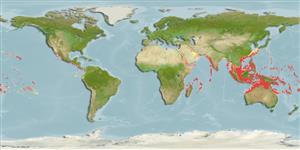Teleostei (teleosts) >
Acanthuriformes (Surgeonfishes) >
Chaetodontidae (Butterflyfishes)
Etymology: Heniochus: Greek, enioi, -ai, -a = sometimes, some + Greek, oche = food (Ref. 45335).
More on authors: Smith & Radcliffe.
Environment: milieu / climate zone / depth range / distribution range
Ecology
Marine; reef-associated; depth range 2 - 250 m (Ref. 90102), usually 15 - 40 m (Ref. 9710). Tropical; 32°N - 23°S
Pacific Ocean: Andaman Islands in the eastern Indian Ocean to Samoa, north to southern Japan, south to Rowley Shoals and New Caledonia.
Size / Weight / Age
Maturity: Lm ? range ? - ? cm
Max length : 30.0 cm TL male/unsexed; (Ref. 48636)
An uncommon species (Ref. 9710) that inhabits deep lagoon and seaward reefs. Adults solitary or in small groups and prefer areas with rich coral growth and high vertical relief (Ref. 1602). Juveniles solitary and secretive on inshore reefs. Largest of the bannerfishes (Ref. 48636). Feed on coral polyps (Ref. 9710). Oviparous (Ref. 205). Form pairs during breeding (Ref. 205).
Life cycle and mating behavior
Maturity | Reproduction | Spawning | Eggs | Fecundity | Larvae
Form pairs during breeding (Ref. 205).
Randall, J.E., G.R. Allen and R.C. Steene, 1990. Fishes of the Great Barrier Reef and Coral Sea. University of Hawaii Press, Honolulu, Hawaii. 506 p. (Ref. 2334)
IUCN Red List Status (Ref. 130435: Version 2024-2)
Threat to humans
Harmless
Human uses
Fisheries: minor commercial; aquarium: commercial
Tools
Special reports
Download XML
Internet sources
Estimates based on models
Preferred temperature (Ref.
123201): 25 - 29, mean 28.1 °C (based on 840 cells).
Phylogenetic diversity index (Ref.
82804): PD
50 = 0.5039 [Uniqueness, from 0.5 = low to 2.0 = high].
Bayesian length-weight: a=0.01995 (0.00906 - 0.04395), b=3.01 (2.83 - 3.19), in cm total length, based on all LWR estimates for this body shape (Ref.
93245).
Trophic level (Ref.
69278): 3.6 ±0.44 se; based on food items.
Resilience (Ref.
120179): High, minimum population doubling time less than 15 months (Preliminary K or Fecundity.).
Fishing Vulnerability (Ref.
59153): Low vulnerability (20 of 100).
Nutrients (Ref.
124155): Calcium = 56.1 [28.3, 91.8] mg/100g; Iron = 0.628 [0.373, 1.013] mg/100g; Protein = 18.7 [17.6, 19.9] %; Omega3 = 0.138 [0.083, 0.228] g/100g; Selenium = 48.2 [26.8, 87.9] μg/100g; VitaminA = 45.8 [13.1, 156.3] μg/100g; Zinc = 0.996 [0.682, 1.426] mg/100g (wet weight);
